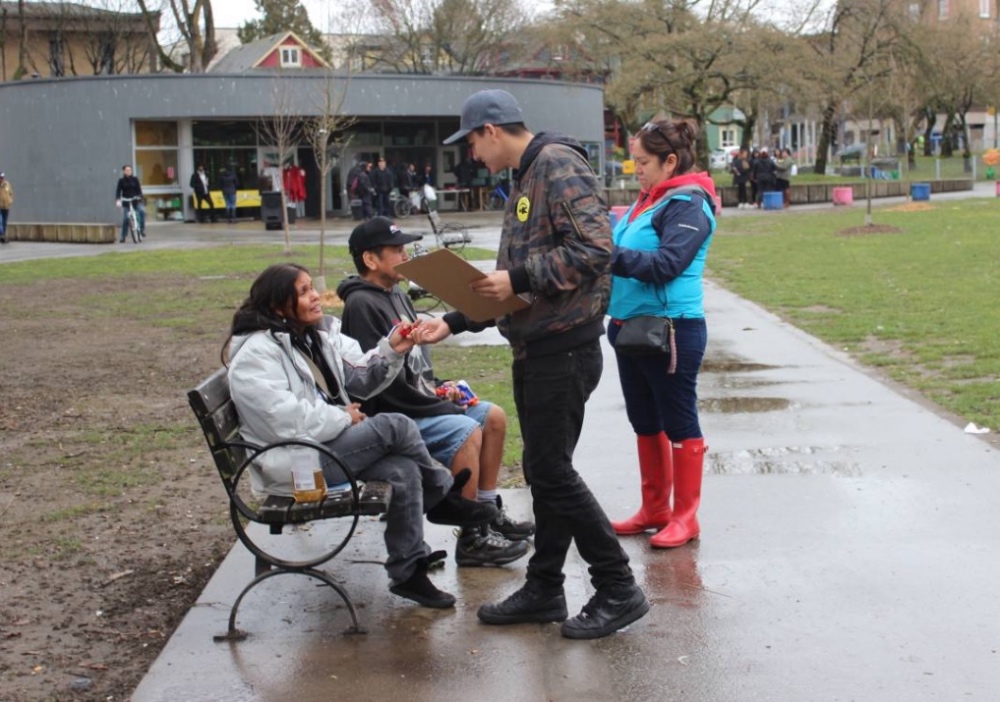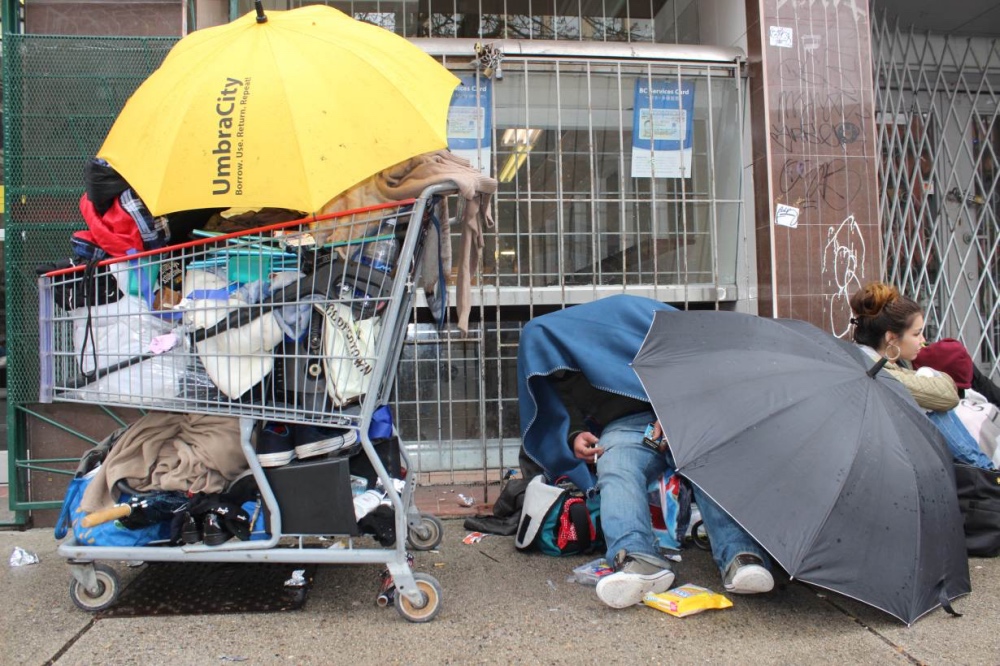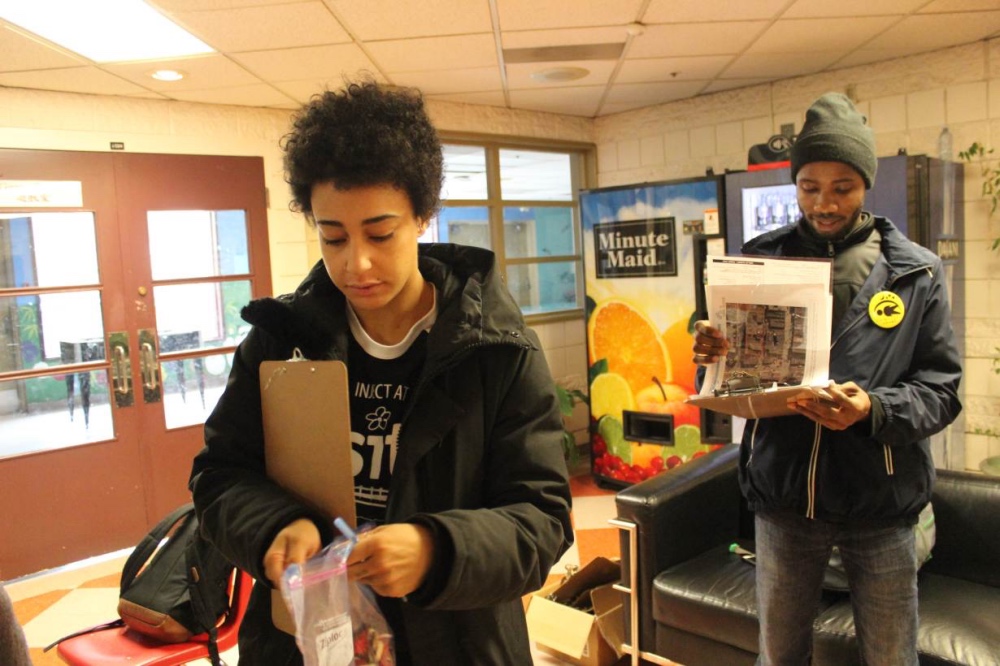
GREGORY SCRUGGS, of Thomson Reuters Foundation, reports from Vancouver in Canada…
Vancouver, Canada
Thomson Reuters Foundation
Melissa Alcock is regularly awoken by strangers.
As a rough sleeper on Vancouver’s Downtown Eastside, her usual alarm is the police, who often rouse her before the working day and encourage her to move along.
But on a recent morning, two women gently shook Ms Alcock awake at 6:30 am, offering a piece of candy.
They were volunteers with the city’s annual homeless count.

Volunteer surveyors offer a tobacco tie to an Indigenous person in Vancouver’s Oppenheimer Park on the day of the city’s annual homeless count, 14th March. PICTURE: Gregory Scruggs/Thomson Reuters Foundation.
While Ms Alcock, 35, would have preferred a cup of coffee, she was open to their questions about her life on the streets.
Once she understood that their pre-dawn chat was intended to determine the size of Vancouver’s homeless population, she hoped the answers might prompt some sort of action.
“When they see how many people are actually out here, maybe then they’ll give their head a shake.”
– Melissa Alcock, a rough sleeper in Vancouver.
“When they see how many people are actually out here, maybe then they’ll give their head a shake,” she told the Thomson Reuters Foundation soon after the volunteers spoke with her.
Ms Alcock, who has been sleeping rough for about a year since losing her housing in Williams Lake, a small town 550 kilometres to the north, complained about city policies that confiscate the possessions of homeless people.
“The city needs to do more to help us,” she said.
Ms Alcock’s hope – that being counted might be the first step towards winning more humane treatment – squares with the belief of experts that such counts really matter.
“It’s important to know how many homeless people you have if you’re going to try and provide housing, shelter, services support all of the non-profits who provide services,” said Vancouver director of homeless services Ethel Whitty.
Vancouver is a bustling city on the west coast of Canada known for its high quality of life. But the downtown district that Ms Alcock calls home is Canada’s poorest postal code, known for high rates of drug addiction, petty crime and prostitution.
Vancouver’s count, which took place in March, is a so-called ‘point in time’ count: a tally of all the homeless people found in a specific window of time at shelters, on sidewalks, under bridges – anywhere people without shelter may spend the night.
Canada conducted at least 61 counts during the country’s spring tallies, an annual event, though a government spokesperson could not provide an exact figure.
In 2016, the latest data available, there were 35,000 homeless Canadians, according to the Canadian Observatory on Homelessness, a research institute.
The United States conducts 399 such counts, covering every state, during the last week of January. In 2017, it estimated there were 553,742 rough sleepers on US streets, an increase in the national figure for the first time in seven years.

A group of indigenous rough sleepers sit on the sidewalk of Vancouver’s Downtown Eastside on the day of the city’s annual homeless count on 14th March. PICTURE: Gregory Scruggs/Thomson Reuters Foundation.
In Vancouver, the definition of homelessness is simple.
Does a person have a place where she or he pays rent? If not, that person is considered homeless, whether they slept on the sidewalk, in a tent, on a friend’s couch or in a shelter.
While the main goal is numbers, if respondents are game to answer questions, surveyors drill deeper and ask about their previous life, income and what brought them down.
Vancouver’s 500 trained volunteers ask 17 questions as they cover 200 routes through the city, doling out tokens of appreciation: candy as well as tobacco ties, a small cloth pouch filled with tobacco that indigenous Canadians use for prayers. Forty per cent of Vancouver’s rough sleepers identify as indigenous, compared to 2.2 per cent nationally.
“You get a snapshot – it’s never a complete count – but then you can also, depending on the resources you have, get greater information about who those are: age, gender, race, those key demographics,” said Barbara Poppe, a homelessness expert who served as former US President Barack Obama’s top official on the subject.
Homeless counts in North America have become much more sophisticated since their first controversial iterations.
In 1990, activists outside the US Department of Commerce warned of an undercount by dumping a great pile of sand adorned with signs reading: “Counting the homeless is like counting grains of sand.”
Nowadays, national governments have a standard methodology that allows city-to-city comparisons, as well as flexibility at the local level to personalise.
So Vancouver runs a daytime count while most cities tally overnight. Houston counts twice to ensure accuracy. New York uses decoys posing as rough sleepers to keep surveyors alert.
Still, cities grapple with grey areas – couch surfers and motel dwellers – that are not as cut and dry as a sleeping bag on a sidewalk.
Cultural norms also differ.
Vancouver’s decision that anyone over 25 living with a relative is homeless does not square with all cultures, Ms Whitty said.

Volunteers surveyors Chloe Milne and Osorochi Madukorom check their route at a community centre in Vancouver on the day of the city’s annual homeless count. PICTURE: Gregory Scruggs/Thomson Reuters Foundation.
Drug addiction and mental health issues can also make surveying difficult. The Thomson Reuters Foundation saw three men smoking meth on a sidewalk on the day of the homeless count who said they had not been counted.
Despite such obstacles, Ms Poppe is optimistic.
“We have definitely seen tremendous improvement in the ability of cities to count effectively and consistently,” she said. “Given where we were 10 years ago, the counts are much more reliable.”
Vancouver reported the results of this year’s count last month. 2,181 people were deemed homeless, a 19 per cent increase since 2014.
Could that number ever be reliably compared with cities around the world? Ms Poppe doesn’t think so.
“The local conditions and the national safety net varies so much between countries that it seems impracticable to do,” she said.





